How Does My Net Metering Power Bill Work
Your power bill includes a whole lot of numbers, and it can be overwhelming to keep track of everything. Adding solar and Net Metering credits to the mix definitely doesn’t help the confusion. Even if it can feel like a chore, understanding the fundamentals of your power bill ensures you don’t ever get overcharged and is a great way to monitor your system’s performance.
We’re going to explain how Net Metering works and do a deep dive into a few power bills.
Net metering policies and power bills will vary by province and utility company. The general concept allows customers to send excess electricity back to the grid in exchange for credits that can be used against future power bills. If your system was just installed during the fall or winter, you probably won’t notice too much production or credits right away. Credits can accumulate throughout the year, with most of your production taking place during the sunnier summer months. These credits are then used to cover the lack of production in the following winter months, creating a balanced and affordable storage system.
Your new and accumulated credits are reflected on your power bill each month. The credits are based on how much electricity you send back to the grid. In most cases, your utility company will record them at the same rate you pay (a 1:1 ratio).
Why Does My Production On My Power Bill Look Low?
Don’t panic if the production you’re seeing on your power bill looks low! The number you see on your bill reflects your excess electricity. This number is only a fraction of your total production. Your utility company doesn’t know how much total electricity your panels generate since the meter only records what you’re sending back to the grid. Therefore, electricity already used by your house won’t be included in your bill.
Check your monitoring app to get a better idea of your overall production.
How to Understand my Net Metering Power Bill
Let’s go through a few examples from 3 different provinces. We’ll let you know how to check your bill and where to find your credits.
Nova Scotia Power Bill
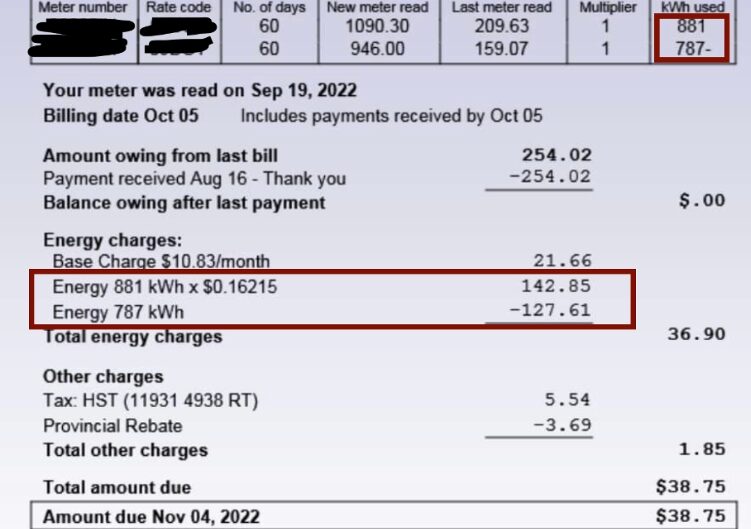
The picture above shows an example of a Nova Scotia power bill.
You should be able to clearly identify how many credits you’re using under the kWh Used and energy charges section. In this example, our customer used 881 kWh and applied 787 kWh worth of credits during this billing period.
Credits are calculated with the same rate that you pay. For this billing period, our customer used $127.51 in credits. This means their total electricity charges for this month are only $15.24. With the fixed fees added, the total for this bill comes up to $36.90.
Again, we’d like to emphasize that the number you’re seeing here only reflects the excess portion of your overall production sent to the grid. We can check the monitoring app to see your total production during this billing period.
Here are 3 graphs that show production from July to September. In this example, our customer just turned on their system in the beginning of July so this is their first full billing period with solar. The billing period shown above is from July 19 to September 19 so we’ll only include those dates in our calculations. We’ve highlighted the dates that are included on the graph for your reference. You can find these charts in the live data section in your customer portal.
July Production
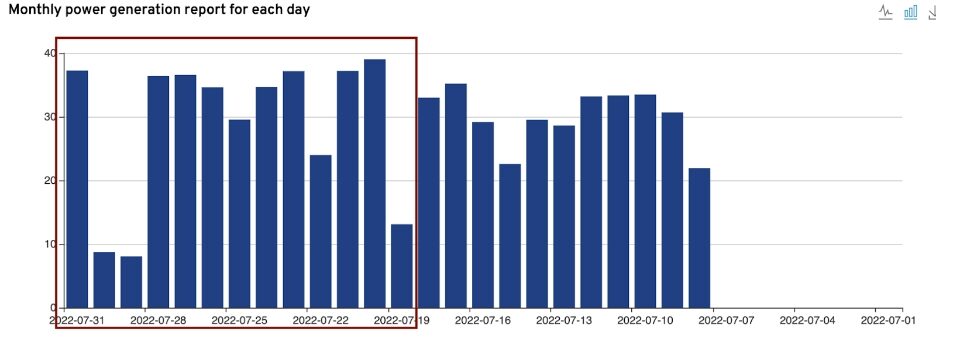
August Production
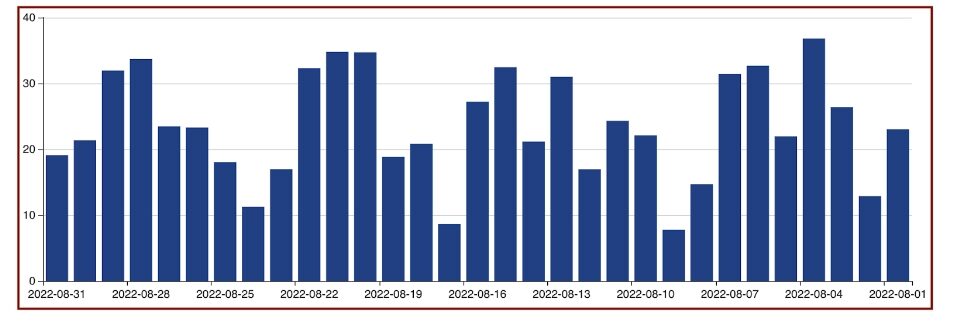
September Production
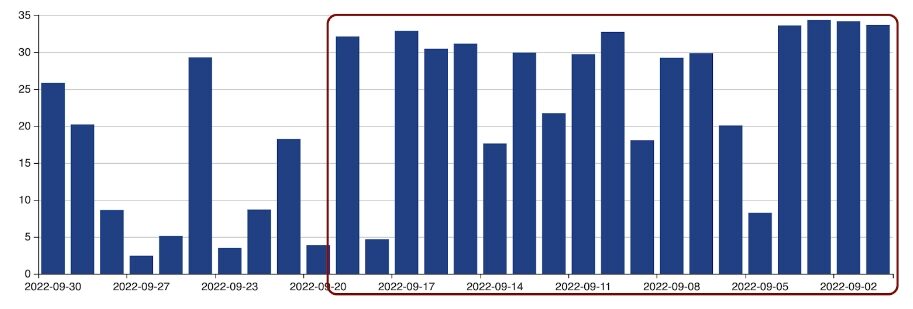
When adding everything up, we can see that the total production during this billing period is actually 1612.5 kWh. Since our customer’s power bill shows applied credits of 787 kWh, we can safely assume around 825,5 kWh (1512.5 – 787) was directly used by their house. This is completely normal and in most cases, you’ll use up a large portion of your production directly.
Some months you’ll send back more than you draw, or you’ll have some accumulated credits saved up. In this case, you can offset the entire energy charge and only be left with the fixed cost. Here’s an example where the entire energy portion was covered by our customer’s credits.

For a summary of how many credits you’ve accumulated, please check the second page of your Nova Scotia Power bill.
Prince Edward Island Power Bill
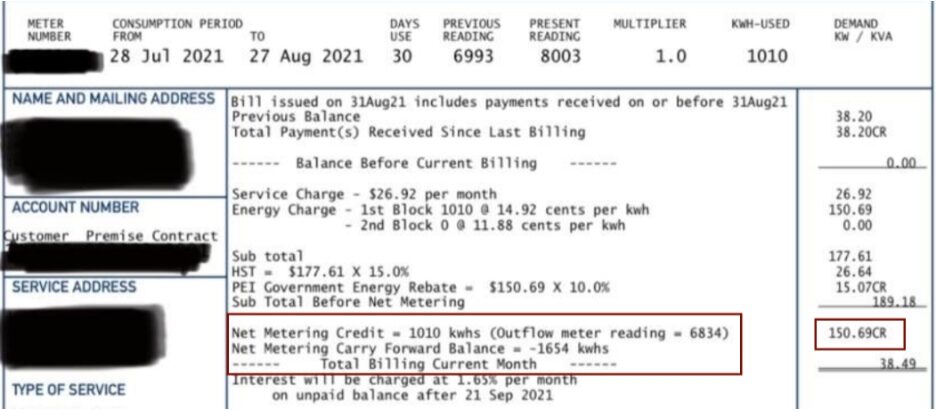
Now let’s move on to a standard power bill in PEI from Maritime Electric. All of your net metering information is in the highlighted area above. It might look a little complicated at first, but we’ll break down what all the numbers mean.
Net Metering Credit: Your net metering credit lets you know the number of credits (kWh) you’re using this billing cycle. In this case, since our customer drew 1010 kWh from the grid, they’ll need to use up 1010 kWh worth of credits to cover their bill.
Outflow meter reading: This number represents the total amount of credits you’ve accumulated this year, including anything you’ve already used. You can check how much electricity you sent to the grid this month by subtracting your previous outflow meter reading with your current one.
Net Metering Carry Forward Balance: This is the number of credits you still have after this billing period.
On the right, you’ll see the amount of money your credits subtracted from your bill. With their excess production and accumulated credits, they had enough to cover the entire energy portion ($150.69) of their electricity bill!
Now let’s go through the live data to see how much total electricity they produced during this billing period.
July Production

August Production
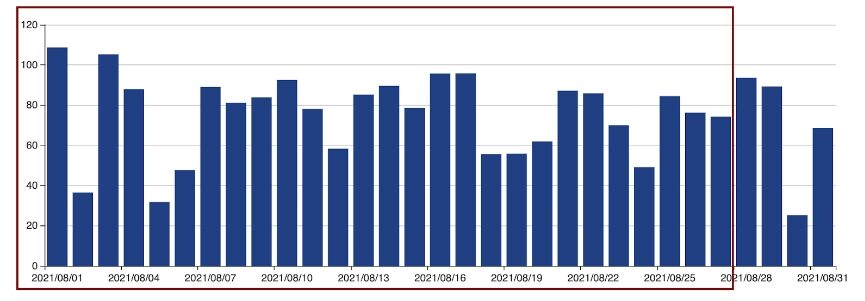
Between July 28th and August 27th, our customer produced a total of 2329.9 kWh. Since these are peak summer days, we can assume that the customer sent back enough electricity to cover their consumption and accumulated a few extra credits for future bills, However, a lot of this production was still used directly by their house and is not reflected on the power bill.
We’d suggest keeping track of your overflow meter reading to get a better idea of how much energy you’re sending back to the grid.
Ontario Power Bill
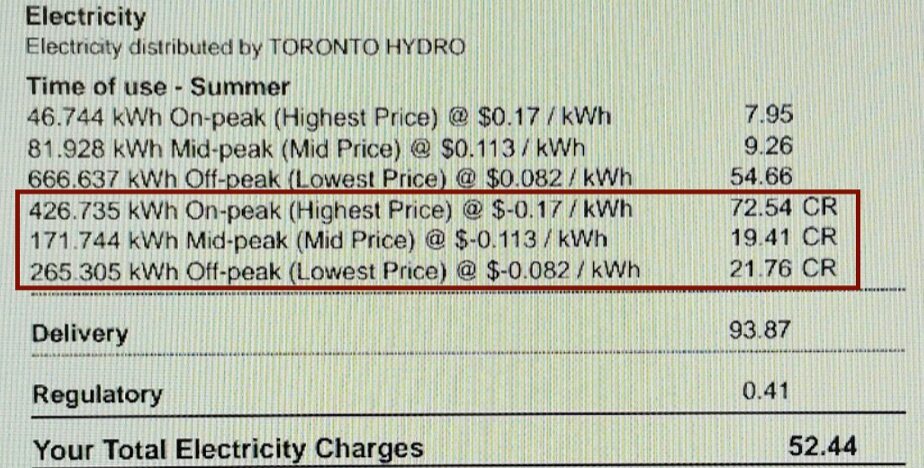
Here’s an example of an Ontario utility bill with net metering. You’ll notice our customer is using the Time of Use rate. Like in the previous provinces, your credits are exchanged at a 1:1 ratio. Since most production happens during On-Peak hours, you’ll be able to balance out your credits with your usage.
You can see how many kWh of credits they’ve earned at each rate in the highlighted section.
Some provinces, like Ontario, will have delivery charges that take up a large chunk of your power bill. Luckily, your credits can be used against these charges too. Our customer earned $113.71 total credits this billing period, which completely offsets their energy charges and part of their delivery fee.
Understanding my Solar Production
Let’s go through a quick final summary to break down everything we’ve learned so far.
- How To Find My Total Production?
Please check your monitoring app or live data to see your total production.
- How much energy am I sending to the grid in the form of credits?
Your meter can only keep track of how much electricity you’re sending back to the grid. The credits on your power bill reflect the amount of electricity you’re sending to the grid.
- How much energy did I take back from the grid?
When your solar panels aren’t producing enough electricity, you’ll still need to draw extra from the grid. Your power bill will let you know how much energy you’ve used from the grid.
- How much solar energy did I use directly?
You can find out how much energy your house used directly from your solar panels with this simple calculation:
App Production – New Power Bill Credits = Direct Solar Usage
For example. If your app shows that you’ve produced 2000 kWh during your billing period and you’ve received 900 kWh worth of credits on your power bill, your house used 1,100 kWh directly. (2000 – 900 = 1,100).
Reduce your Power Bill for Good With Solar
We hope this helps explain how your net metering power bill works. Again, each utility company will have their own policies regarding Net Metering. It’s always best to confirm how their specific credit system works before installing your panels.
We still totally understand if you’re feeling overwhelmed with your post-installation solar power bill. If you have any questions about your system or production, please feel free to contact us. At Polaron, our goal is to make the solar experience completely stress-free from start to finish.
